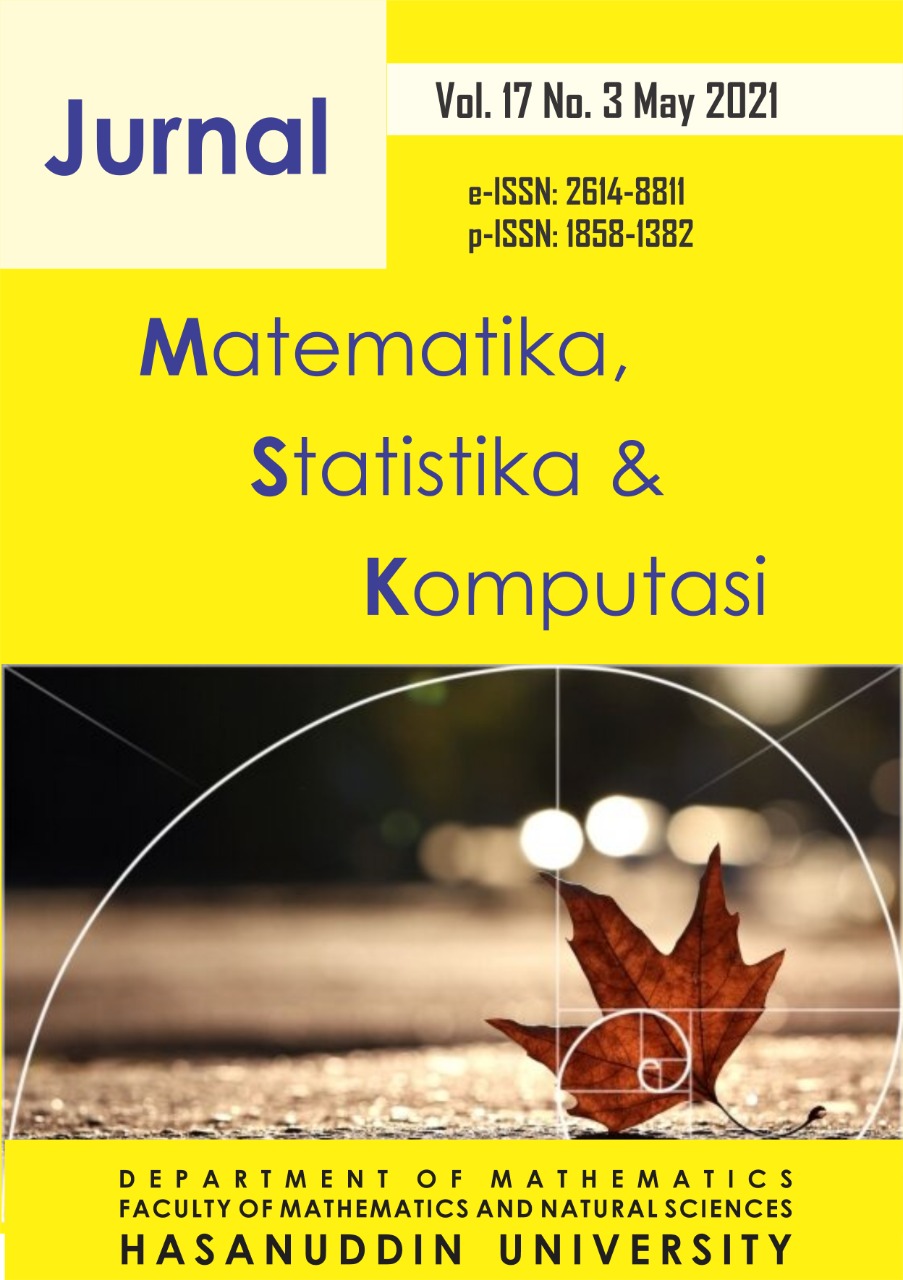Estimation of the Portfolio Risk from Conditional Value at Risk Using Monte Carlo Simulation
DOI:
https://doi.org/10.20956/j.v17i3.11340Keywords:
Risk, Value at Risk (VaR), Monte Carlo simulation, Conditional Value at Risk (CVaR)Abstract
Portfolio risk shows the large deviations in portfolio returns from expected portfolio returns. Value at Risk (VaR) is one method for determining the maximum risk of loss of a portfolio or an asset based on a certain probability and time. There are three methods to estimate VaR, namely variance-covariance, historical, and Monte Carlo simulations. One disadvantage of VaR is that it is incoherent because it does not have sub-additive properties. Conditional Value at Risk (CVaR) is a coherent or related risk measure and has a sub-additive nature which indicates that the loss on the portfolio is smaller or equal to the amount of loss of each asset. CVaR can provide loss information above the maximum loss. Estimating portfolio risk from the CVaR value using Monte Carlo simulation and its application to PT. Bank Negara Indonesia (Persero) Tbk (BBNI.JK) and PT. Bank Tabungan Negara (Persero) Tbk (BBTN.JK) will be discussed in this study. The daily closing price of each BBNI and BBTN share from 6 January 2019 to 30 December 2019 is used to measure the CVaR of the two banks' stock portfolios with this Monte Carlo simulation. The steps taken are determining the return value of assets, testing the normality of return of assets, looking for risk measures of returning assets that form a normally distributed portfolio, simulate the return of assets with monte carlo, calculate portfolio weights, looking for returns portfolio, calculate the quartile of portfolio return as a VaR value, and calculate the average loss above the VaR value as a CVaR value. The results of portfolio risk estimation of the value of CVaR using Monte Carlo simulation on PT. Bank Negara Indonesia (Persero) Tbk and PT. Bank Tabungan Negara (Persero) Tbk at a confidence level of 90%, 95%, and 99% is 5.82%, 6.39%, and 7.1% with a standard error of 0.58%, 0.59%, and 0.59%. If the initial funds that will be invested in this portfolio are illustrated at Rp 100,000,000, it can be interpreted that the maximum possible risk that investors will receive in the future will not exceed Rp 5,820,000, Rp 6,390,000 and Rp 7,100,000 at the significant level 90%, 95%, and 99%Downloads
References
Artzner, P., Delbaen, F., Eber, J-M., Heath, D. 1999. Coherent Measures of Risk. Mathematical Finance. Vol. 9, No. 3, 203-228.
Conover. 1980. Practical Nonparametic Statistics. New York: John Willey & Sons.
Fabozzi, F. J. 1999. Manajemen Invetasi. Jakarta: Salemba Empat.
Halim, A. 2005. Analisis Investasi. Jakarta : Salemba Empat.
Hidayati, H., Dharmawan, K., & Sumarjaya, I. W. 2015. Estimasi Nilai Conditional Value at Risk Menggunakan Gaussian Copula. E-Jurnal Matematika. Vol. 4, No.4, 188-194.
Husnan, Suad. 2002. Dasar-dasar Teori Portofolio dan Analisis Sekuritas. Edisi ketiga. Yogyakarta: UPP AMP YKPN.
Jorion, P. 2007. Value at Risk: The New Benchmark for Managing Finanancial Risk. Third Edition. New York: The Mc Graw-Hill Companies.
Markowitz, Harry. 1959. Portfolio Selection: Efficient Diversification of Investments. New York: John Wiley & Sons, Inc.
Purnamasari, N. A. 2017. Backtesting untuk Value at Risk pada Data Return Saham Syariah Menggunakan Quantile Regression. Tesis. Surabaya: Intitut Teknologi Sepuluh Nopember.
Rockafellar, R. & Uryasev. 2000. Optimization of Conditional Value at Risk. Journal of Risk. Vol.2, No.3, 21-41.
Rodoni, Ahmad & Herni Ali. 2014. Manajemen Keuangan Modern. Jakarta: Mitra Wacana Media.
Rubinstein, R.Y. 1981. Simulation and Monte Carlo Method. New York: Willey & Sons.
Sofiana, Nita. 2011. Pengukuran Value at Risk pada Portofolio dengan Simulasi Monte Carlo. Skripsi. Yogyakarta: Program Studi Matematika Universitas Negeri Yogyakarta.
Tandellin, Eduardus. 2007. Analisis Investasi dan Manajemen Portofolio. Yogyakarta: BPFE.
Downloads
Published
How to Cite
Issue
Section
License
Copyright (c) 2021 Author and publisher

This work is licensed under a Creative Commons Attribution 4.0 International License.

This work is licensed under a Creative Commons Attribution 4.0 International License.
Jurnal Matematika, Statistika dan Komputasi is an Open Access journal, all articles are distributed under the terms of the Creative Commons Attribution License, allowing third parties to copy and redistribute the material in any medium or format, transform, and build upon the material, provided the original work is properly cited and states its license. This license allows authors and readers to use all articles, data sets, graphics and appendices in data mining applications, search engines, web sites, blogs and other platforms by providing appropriate reference.








